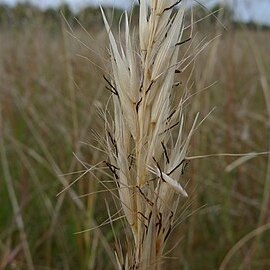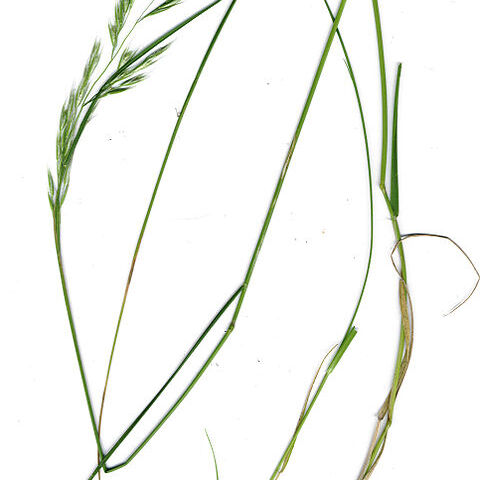Perennial, caespitose, mat-forming or cushion-forming, bisexual. Leaves: ligule a very short ciliate membrane or a fringe of hairs; blade once-folded in bud. Inflorescences paniculate (sometimes almost a raceme, or reduced to a single spikelet) or a single raceme. Spikelets pedicellate, laterally compressed, with 2–8 bisexual florets, disarticulating obliquely between florets; rachilla usually prolonged beyond bisexual florets with incomplete florets, or terminating at a bisexual floret. Glumes 2, ±equal, long relative to the adjacent lemma, awnless, keeled towards apex, 3–7-nerved. Callus short, less than 0.7 times the combined length of callus and rachilla internode. Lemma 2-lobed or entire, 1-awned or rarely mucronate, dorsally rounded, 3–9-nerved, with indumentum on back usually tufted in 2 untidy transverse rows, or glabrous; lobes acute, acuminate or terminating in setae, often partially fused to the awn base; awn median, from sinus, geniculate, entered by several nerves. Palea relatively long. Hilum short, usually punctiform. Embryo waisted or not waisted.
Perennials, rhizomatous or caespitose, bisexual. Ligule a fringe of hairs. Inflorescences paniculate. Spikelets pedicellate, laterally compressed, with 3–6 bisexual florets, disarticulating between florets; rachilla prolonged beyond bisexual florets with incomplete florets. Glumes 2, ±equal, awnless, carinate, 1–7-nerved. Callus slightly shorter than rachilla internode. Lemma deeply 2-lobed (tapering into apical setae), 1-awned, rounded on back, 9-nerved, hairy; awn median, from sinus, geniculate, with base twisted; indumentum on back scattered on lower 1/2 or 2/3, not in tufts (or scarcely so), not in transverse rows. Palea relatively long. Lodicules ciliate. Stigmas red. Hilum linear to ovate, almost 1/5–1/2 as long as grain.
Perennials, caespitose, bisexual. Leaves: ligule a fringe of hairs; blade 0.3–2 mm wide. Inflorescences paniculate, open. Spikelets pedicellate, laterally compressed, with 2–7 bisexual florets, disarticulating between florets; rachilla prolonged beyond bisexual florets with incomplete florets. Glumes 2, ±equal, awnless, carinate, 3–7-nerved. Callus short. Lemma 2-lobed (tapering into slender setae), 1-awned, rounded on back, 9-nerved, hairy; awn median, from sinus, geniculate; indumentum on back usually shortly felted on body, with upper margin at sinus of much longer hairs, obscurely tufted. Palea relatively long. Lodicules ciliate. Hilum short, less than 1/3 caryopsis length. Embryo waisted.
Spikelets 3–10-flowered; glumes subequal, as long as the spikelet or almost so; floret callus short to narrowly oblong, rarely linear, obtuse (sometimes narrowly so); lemmas rounded on the back, 5–9-nerved, bearing tufts of hairs arranged in 2 transverse series, these sometimes reduced to 2 marginal tufts, rarely represented by a transverse band of longer hairs, 2-lobed at the apex, the lobes usually awned, with a straight or geniculate awn in the sinus; palea usually longer than the body of the lemma, the keels glabrous, wingless.
Inflorescence a contracted panicle, sometimes reduced to a raceme.


